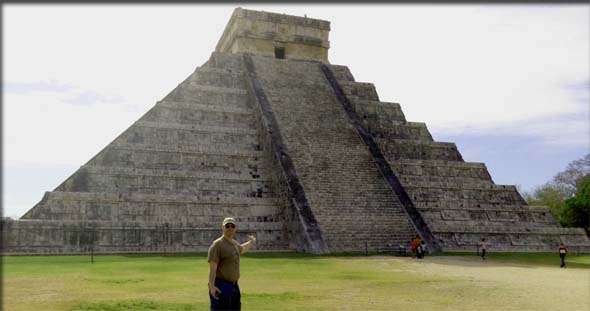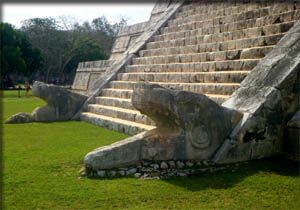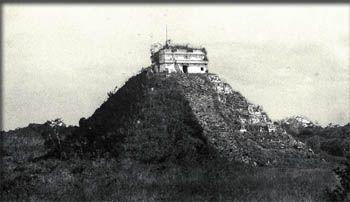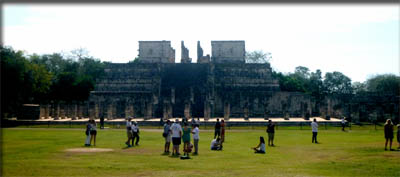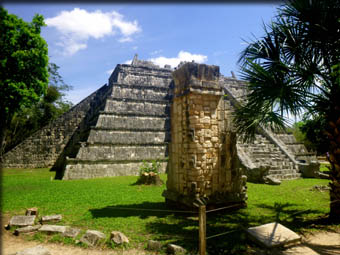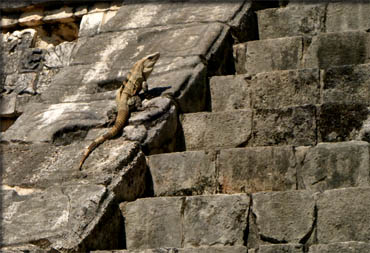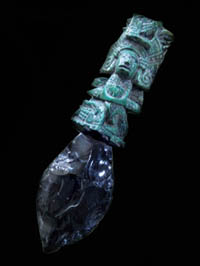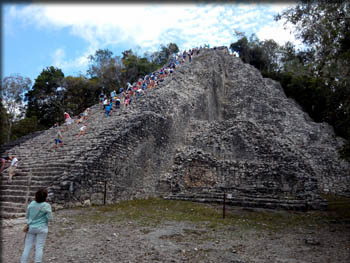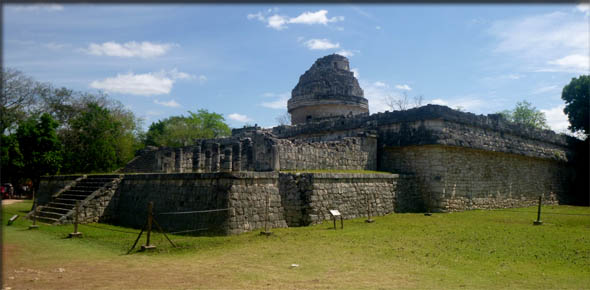pop up description layer
HOME
Cryptozoology UFO Mysteries Aviation Space & Time Dinosaurs Geology Archaeology Exploration 7 Wonders Surprising Science Troubled History Library Laboratory Attic Theater Store Index/Site Map Cyclorama
Search the Site: |
|
From the Curator's Office: A Visit to Chichen Itza
(8/16) Probably one of the most famous and most easily accessible ancient sites in the Western Hemisphere is the Mayan city of Chichen Itza. A few years ago I listed it as one of the ten mysterious locations I wanted to visit during my life. So a few months back I decided to take the plunge and hopped on a jet for the Mexican Yucatán Peninsula with the idea of having a little adventure at this "Wonder of the World." What makes this site so easy to get to is its whereabouts it's only a few hours from some of the most famous beaches in the world along what they like to call the Mayan Riviera. This includes the resort cities of Cancun, Playa del Carmen and Tulum. Because of the high traffic to these tourist havens, there are plenty of flights in and out of the Cancun Airport, and a vast number of available hotel rooms.
I booked six days and five nights at the Barcelo Costa Cancun for about $1,000 per person ( Groupon deal) which included the airfare out of New York. The amenities there included all food and drinks, so we spent very little after we actually arrived at our destination. The Barcelo is at the most northern edge of the "Hotel Zone," which runs north to south along an island with the Caribbean Ocean to the east and a lagoon along the west. Getting anywhere along the hotel zone is easy; for 50.5 pesos ($3) you can ride the public buses along the length of the island. Chichen Itza is about a three-hour drive inland from the coast. It is possible to rent a car and make the drive yourself, but I decided since this was my first trip into the area to utilize an organized tour to see certain Mayan sites in which I was interested. Cancun is a popular location with a huge amount of tour possibilities. While quite a few of them are for the Mayan ruins in the area, others can get you to ecological entertainment parks, scuba diving off the coast or other tourist attractions. We decided to take two of the tours involving major Mayan sites; one to Chichen Itza and the other to a less well-known location, Coba. The tour I settled on was entitled "Chichen Itza with a Private Archeologist." I have some doubts if our guide was actually a card-carrying archeologist (if there is such a thing) but he was certainly familiar with the history of the area and the city and provided an engaging insight to what we were seeing during the trip. Chichen Itza History
We know there was a settlement at the location of Chichen Itza (which means "at the mouth of the well") as early as 600 AD. Around 900 AD it became an important regional capital. It was during this period that El Castillo (Spanish for "the castle") was built. It is more properly called the Temple of Kukulcan and is easily the most well-known structure at Chichen Itza. Standing 78 feet (24 m) high, with a 19 foot (6 m) tall temple ceremonial room on top, it's designed as a stepped pyramid with steep staircases on all four sides. The temple was dedicated to the god Kukulkan, a feathered serpent. The temple is famous for two oddities: first, clapping your hands at a certain distance from the temple gives you an echo that sounds like the call of the Mexican quetzal bird, a sacred animal in Mayan culture. The second is a crawling motion that appears along the serpent-shaped staircases during the spring and fall equinox. This is caused by the motion of the sun as it hits the stepped corners of the pyramid and casts shadows on the stair borders. For the tourist arriving at Chichen Itza, the temple, rather spectacular in appearance, acts as a centerpiece to the restored city. As you come from the visitor's center into the park, you walk down a short jungle path that lets out into the city and the temple appears before you. The grassy area around the pyramid has been cleared of jungle and the sides of the temple facing you have been heavily restored. Most of the newer portion of the city (constructed after 900 AD) surrounds this central struture.
Chichen Itza, selected in 2007 as one of the "New Seven Wonders of the World," is easily the most popular archeological site in the Yucatán and on a typical afternoon it will be mobbed with tourists. In addition, the park allows vendors to set up along the paths. All this activity can be a problem if you want to take pictures of the ancient structures without dozens of people in the way. To avoid this, I selected an early tour that arrived just after the park opened. The only problem with this was that we had to be ready to be picked up at the entrance to our hotel at about 5:30 in the morning, rather than a more typical 10 A.M. This early tour did have the advantage of getting back to the hotel in the late afternoon, however, rather than the evening. This meant we got to spend at least a couple of daylight hours relaxing around the pool or on the beach each day. Surrounding the Temple of Kukulcan are a number of other structures. To the west is the Temple of the Warriors, a large, stepped pyramid with rows of carved columns depicting warriors in front and on the sides. It's thought that the columns would have supported a roof made of wood or other similar materials at the time the city was occupied. Our guide suggested it might have been a market place.
Toward the northwest of the Temple of Kukulcan is the Great Ball Court composed of two massive walls on either side of a grassy playing area. The exact rules of the game aren't known and probably varied over time, but it is thought that the players needed to keep a heavy rubber ball in the air by hitting it with their hips. Extra points could be gained by managing to put the ball through stone hoops mounted high on the walls. Human sacrifice was somehow linked to the game, and a player with his head decapitated is pictured on stone reliefs at the court. A short walk down a jungle path to the southwest leads to the older section of the city. Here there is a smaller pyramid temple, other structures and a building known as El Caracol (which translates to "The Snail" ) because of a spiral internal staircase. El Caracol is thought to be an observatory and it looks exactly like you would expect: a large, stepped platform with the remains of what appear to be a dome on top (though it's actually what's left of a cylindrical tower). Archeologists have discovered sight lines for at least 20 different astrological events in the building. Most tours that I looked at followed a similar schedule with a bus trip out to the site taking two hours (some had a built-in shopping stop which made the trip a bit longer) followed by several hours at the city and then a return to your hotel. Our particular tour allowed three hours in the archeological park roughly divided halfway between time with our tour guide and the other half of the time to walk around the city by yourself. If you go, I would suggest choosing a tour that gives you at least 3 hours on the site to look around. Even with that amount of time I felt a bit rushed.
Unlike a national park site in the United States, vendors selling souvenirs and local art are allowed to set up along most of the paths, though not in the area directly around the Temple of Kukulcan. While this seemed to bother some visitors, I thought that it was perhaps a good way for people local to the area to get some economic advantages out of having the site in their province. Interestingly enough, with so many venders selling similar items, it was probably the cheapest place to pick up some souvenirs of your trip if you want them. My son asked me to bring him back an obsidian knife. I also selected a ceramic whistle, designed to sound like the snarl of a jaguar, for myself. With a little bargaining, I got the knife for 150 pesos (About $10) and the whistle for another 90 pesos. Coba
As amazing as Chichen Itza was, I also wanted to see an archeological site that was less developed. So the next day we took another early trip to the city of Coba. Coba, which is about 70 miles southwest of Chichen Itza, gives you a much better idea of what these cities looked like when the first explorers came across them. Very little of the jungle, except directly in front of the ruins, has been cleared and very little of the ruins have been reconstructed. The site is much more spread out with less of it accessible to visitors. In fact, the site is so large it makes sense to rent a bike to get around the place. Because many of the ruins are only cleared from the jungle on only one side, it's often possible to walk around the other side and see what they looked like originally. Generally, they appear as simply a hill covered with thick vegetation. You might not even think you were looking at something man-made, except theYucatán is so flat almost any large mound suggests an artificial edifice. Unlike Chichen Itza, the few paths at Coba are more linear in nature and it made sense to move through the park as a tour group taking a few minutes at each notable ruin. There are a number of smaller pyramid temples here and several ball courts (though none anywhere near as large as the one at Chichen Itza). At the end of the trail is perhaps the most intriguing structure at Coba is the Nohoch Mul Pyramid. At 137 feet (42 meters), it is the tallest ancient temple in the Yucatán and the last that is accessible to visitors for climbing (the Temple of Kukulcan was closed after someone fell off it and was killed in 2006). The top provides a wonderful view of the surrounding jungle and standing there on the ancient mound you feel a bit like Indiana Jones. Undoubtedly, the authorities will eventually move to close this ruin, also, so I'm glad I got to see it while it was still accessible.
Sacred Cenotes The Coba trip included the chance to visit a privately owned cenote just outside the park. The Yucatán has no above-ground rivers or streams, so access to fresh water through these sinkholes was extremely important to the ancient Mayans and they were considered sacred. Cities were built where one or more cenotes existed. While these can take the form of a small lake with steep banks, the one we saw just outside Coba was underground with just a small access hole at the top opening into a circular room over a hundred-feet wide and filled with water. A wooden, spiral staircase extended down to a platform that allowed us to swim in the cool underground lake, a nice relief from the hot midday sun. There are a large number of cenotes you can visit in the Yucatán for swimming or snorkeling. While you can drive to a cenote yourself and pay a visiting fee, they are often included as a stop on a larger tour of Mayan ruins like Coba or Chichen Itza. Before returning to our hotel, the Coba trip included lunch at a café just outside of the archeological park. The small café was a nice change from the larger restaurants at the resort and featured probably the most authentic Mexican food we got to sample during our trip. Nobody is quite sure why the Mayans seem to started abandoning their cities around the 9th century. Some theories suggest that a severe drought, made worse by the deforestation of the area (land without shade is less likely to retrain water) may have forced the Mayans to seek a more hospitable environment. Chichen Itza and Coba are far from the only Mayan ruins in the area. A small one exists right in the hotel zone at Cancun. There is also a major ruin at Tulum that overlooks the sea. If you visit the Yucatán you should not miss the opportunity to explore these sites and the chance to connect yourself with the fascinating, ancient Mayan world.
Copyright 2016 Lee Krystek. All Rights Reserved. |
|
Related Links |
|
|



